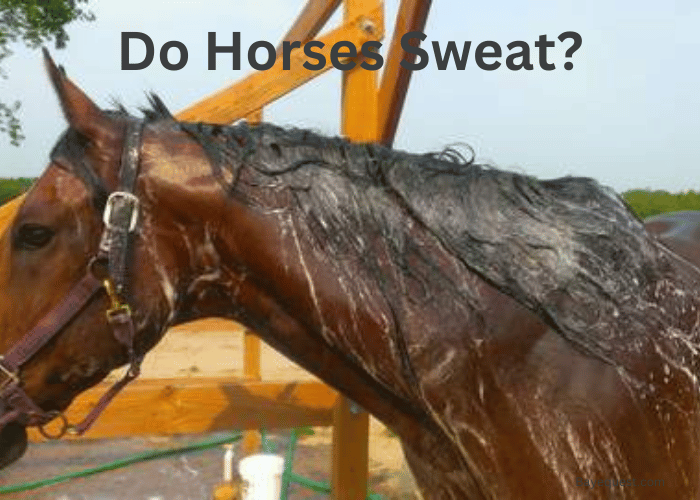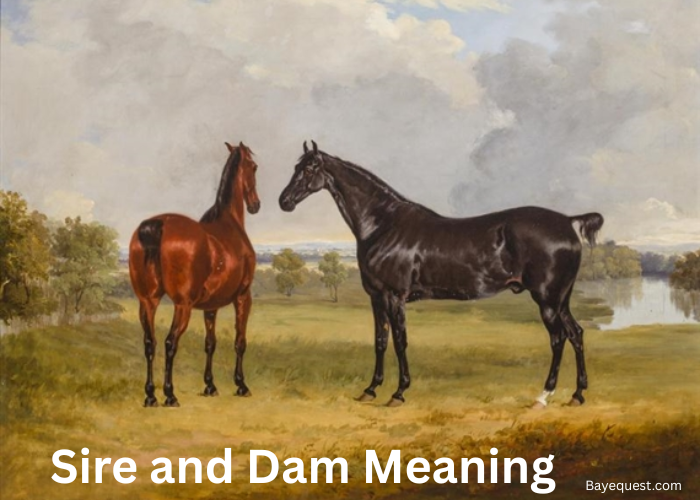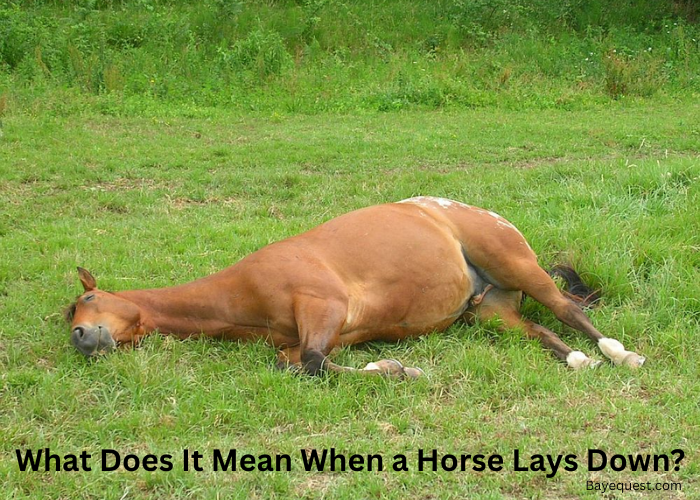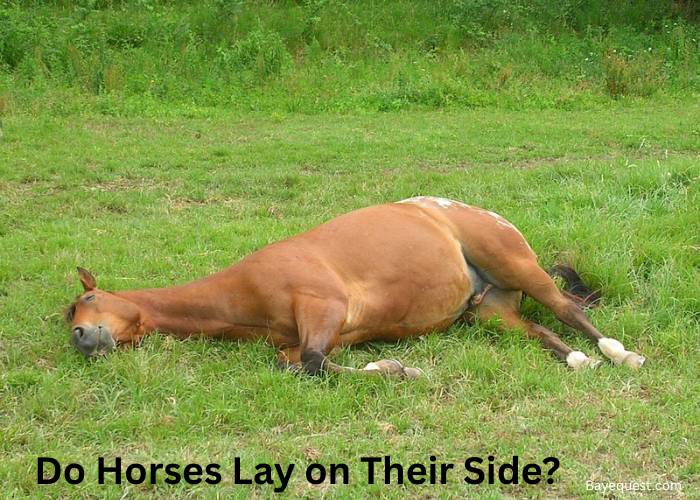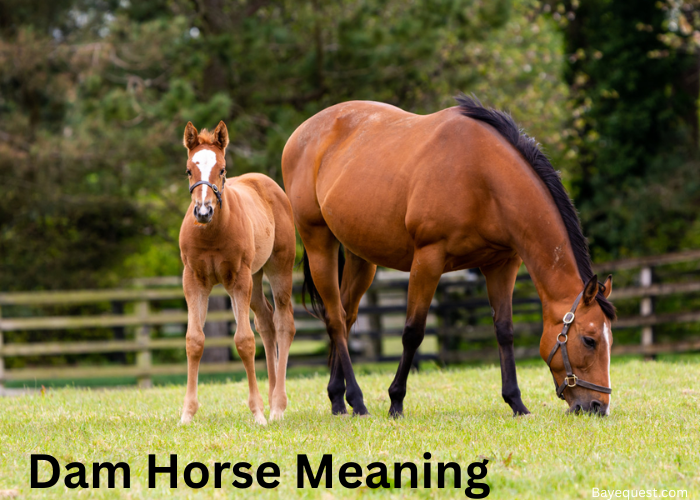Have you ever wondered if horses sweat? Spoiler alert: they do. But it’s not just any sweat.
Horse sweat is a fascinating mix of biology and equine magic. It cools them down, moistens their skin, and even helps them show off during a hard ride.
In this blog, we’ll dive into the hows and whys of horse sweat. You’ll learn what makes it special, why it’s crucial for their health, and how you can help your horse manage the heat.
Get ready to saddle up for some sweaty secrets.
Do Horses Sweat? Key Takeaway
Yes, horses sweat. They have sweat glands all over their bodies. Sweating helps them cool down, especially after exercise. Horse sweat contains water, electrolytes, and proteins. It’s crucial for regulating their body temperature. If horses couldn’t sweat, they’d overheat quickly. So, yes, horses do sweat, and it’s vital for their health.
How Do Horses Sweat?
Horses sweat through their skin using special sweat glands. These are called apocrine glands.
When a horse gets hot, the brain sends a signal to the sweat glands, telling them to start producing sweat.
The sweat is made up of water, electrolytes, and proteins. One important protein is called latherin.
Latherin helps the sweat spread evenly over the horse’s skin. This makes cooling more effective.
As the sweat spreads, it begins to evaporate. Evaporation takes heat away from the horse’s body.
This process cools the horse down. Without sweating, horses would overheat quickly.
Sweating is essential for horses. It helps them stay cool during exercise or in hot weather, and this natural cooling system is vital for their health and well-being.
Why Do Horses Sweat?
Horses sweat to regulate their body temperature.
When they exercise or when it’s hot, their bodies produce heat. Sweating helps cool them down.
The sweat, which is mostly water, spreads over their skin. As it evaporates, it takes heat away from their bodies.
Sweating also helps remove waste products. During intense exercise, muscles produce waste like lactic acid. Sweat helps carry some of these wastes out of the body.
Electrolytes in the sweat, like sodium and potassium, are essential for muscle function and hydration. Sweating helps balance these electrolytes.
Without sweating, horses would overheat, leading to serious health issues. So, sweating is crucial for their overall health and performance.
How Much Sweat Do Horses Produce?
Horses can sweat a lot. In hot weather or during hard exercise, they can produce up to 10-15 liters of sweat per hour. That’s around 2.5-4 gallons.
Sweating helps them stay cool, but it also means they need lots of water and electrolytes.
Without enough, they can get dehydrated. So, keeping a sweating horse well-hydrated is crucial.
Composition of Horse Sweat
This table outlines horse sweat’s main components, descriptions, and functions in maintaining the horse’s health and cooling system.
| Component | Description | Function |
| Water | The primary component of sweat | Helps cool the body through evaporation |
| Sodium (Na) | An essential electrolyte | Maintains fluid balance, nerve function, and muscle contraction |
| Potassium (K) | Another key electrolyte | Regulates heartbeat, muscle function, and fluid balance |
| Chloride (Cl) | An important electrolyte | Works with sodium to maintain fluid balance and nerve function |
| Calcium (Ca) | A minor component | Plays a role in muscle contraction and nerve transmission |
| Magnesium (Mg) | A minor component | Involved in muscle and nerve function, and enzyme activation |
| Latherin | A protein specific to horse sweat | Helps spread sweat evenly across the skin for better evaporation |
Factors Influencing Sweating in Horses
Understanding what influences horse sweating is key to keeping them healthy. Here are the main factors that affect horse sweating:
Physical exertion and exercise
When horses engage in physical activity, their muscles generate heat. To prevent overheating, their bodies start sweating.
Sweating cools them down by evaporating from their skin. The more intense the exercise, the more sweat is produced.
This is crucial for maintaining a safe body temperature during and after strenuous activity.
Environmental factors
Temperature and humidity significantly impact how much horses sweat. In hot weather, horses sweat more to cool down.
High humidity levels can make it harder for sweat to evaporate, reducing the cooling effect.
This can cause horses to sweat even more as their bodies try to compensate for the reduced cooling efficiency.
Stress and anxiety
Horses, like humans, can sweat when they are stressed or anxious. Stress triggers the release of adrenaline, which can stimulate sweat glands.
Situations such as transportation, unfamiliar environments, or the presence of unfamiliar animals can cause stress-induced sweating.
This type of sweating helps prepare the body for a ‘fight or flight’ response.
Health conditions
Certain health conditions can affect a horse’s ability to sweat. Anhidrosis is a condition where horses can’t sweat properly.
This makes it hard for them to cool down, especially in hot weather. Other conditions, like dehydration or electrolyte imbalances, can also impact sweating.
Always monitor and manage these conditions to ensure the horse’s health and well-being.
Signs of Sweating in Horses
Here are some common signs of sweating in horses:
Visible wet coat
One of the most obvious signs is a wet or damp coat. Sweat can make the horse’s hair look darker and feel wet to the touch, especially in areas like the neck, flanks, and shoulders.
Lathering
In some cases, you might see white, foamy sweat, especially in areas of heavy sweating, like between the hind legs and under the saddle.
This is due to the protein latherin, which helps spread the sweat over the coat.
Dripping sweat
When a horse sweats heavily, you might see sweat dripping from their body. This is common after intense exercise or in very hot weather.
Increased drinking
A sweating horse will often drink more water to replace the fluids lost through sweat. If you notice your horse drinking more than usual, it could be due to sweating.
Seeking shade or cooler areas
Horses may seek shade, fans, or breezy spots to help cool down. This behavior can indicate sweating and trying to lower their body temperature.
Changes in behavior
If horses are sweating heavily, they might become restless, paw the ground, or show signs of discomfort. These behavioral changes are a response to the discomfort caused by excessive sweating and heat.
Interesting read: Do Horses Puke?
Common Sweating Issues in Horses
These two are the common sweating issues in horses:
Anhidrosis (inability to sweat)
Anhidrosis is a condition where horses are unable to sweat properly. This condition is more common in hot and humid climates.
The exact cause of anhidrosis is not well understood, but it is believed to involve a dysfunction of the sweat glands. Normally, the hypothalamus in the brain signals sweat glands to produce sweat to cool the body.
In horses with anhidrosis, these signals do not result in adequate sweat production. As a result, these horses struggle to regulate their body temperature.
Symptoms include dry coat during heat and exercise, rapid breathing, and elevated body temperature. Management often includes keeping the horse cooler and providing shade, fans, and misting systems.
Using supplements may help improve sweat production.
Over-sweating and electrolyte imbalance
Over-sweating, or hyperhidrosis, occurs when a horse sweats excessively. This is often due to intense exercise, high temperatures, or stress.
While sweating is crucial for cooling, excessive sweating can lead to fluid and electrolyte loss. Electrolytes such as sodium, potassium, and chloride are essential for muscle function, nerve transmission, and maintaining fluid balance.
When a horse loses too many electrolytes through sweat, it can result in an electrolyte imbalance. This imbalance can cause muscle cramps, fatigue, weakness, and metabolic disturbances like thumps (synchronous diaphragmatic flutter).
Proper management includes providing plenty of fresh water and using electrolyte supplements. Monitoring the horse’s condition and adjusting their workload and environment can also help manage excessive sweating.
How to Manage Sweating in Horses
Managing horse sweat is crucial for their health. Here are key tips to keep your horse cool and comfortable.
Keep them hydrated. Ensure fresh water is always available. Horses need to drink plenty to replace lost fluids.
Provide electrolytes. Use electrolyte supplements, especially in hot weather or after intense exercise. This helps balance their body salts.
Use cooling techniques. Cool your horse with fans, misting systems, or hose them down with cool water. Focus on areas like the neck, chest, and legs.
Offer shade and ventilation. Make sure your horse has access to shade. Good ventilation in barns and stalls helps keep them cool.
Monitor for dehydration. Check for signs of dehydration like dry gums, sunken eyes, and reduced skin elasticity. Act quickly if you notice these signs.
Adjust workloads. Reduce exercise intensity in hot weather. Work your horse during cooler parts of the day, like early morning or late evening.
Groom regularly. Regular grooming helps keep the coat clean and sweat-free, improving cooling efficiency.
Use cooling blankets. After exercise, use a cooling blanket to help bring their body temperature down gradually.
Signs of Heat Stress
Recognizing heat stress in horses is crucial. Here are the key signs to watch for to keep your horse safe and healthy.
1. Heavy sweating. Excessive sweat, even in shaded or resting conditions, indicates overheating.
2. Rapid breathing. Fast, shallow breaths can signal your horse is struggling to cool down.
3. Increased heart rate. A consistently high pulse rate, even after resting, suggests heat stress.
4. Lethargy. Lack of energy or reluctance to move can be a warning sign.
5. Dehydration. Dry gums, sunken eyes, and reduced skin elasticity show dehydration.
6. Elevated body temperature. A rectal temperature above 103°F (39.4°C) indicates potential heat stress.
7. Nostril flaring. Flared nostrils and labored breathing are signs of severe heat stress.
8. Uncoordinated movements. Stumbling or difficulty walking can occur if heat stress worsens.
9. Dark urine. Concentrated, dark-colored urine indicates dehydration and heat stress.
10. Loss of appetite. Reduced interest in food can be a sign your horse is overheated.
Conclusion
So, do horses sweat? Absolutely. And it’s a good thing they do. Sweating keeps them cool and healthy.
Whether they’re galloping in the fields or standing in the sun, sweat plays a vital role. Monitor their hydration and look for signs of heat stress.
Managing their sweat means happier, healthier horses. So next time you see your horse sweating, remember it’s their natural cooling system.
Stay cool, and keep your horse cooler. Happy riding.




